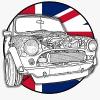How Do I Find Out My Final Drive?
#1

Posted 18 April 2011 - 09:14 AM
Thanks
#2

Posted 18 April 2011 - 12:38 PM
There s a relatively easy method that works assuming the drop gears haven't been messed with. We know that 4th in an A-Series box is 1:1 through the gearbox and assuming that the drops are standard ratio (again 1:1) then if you stick the gearbox in 4th and turn the engine then each single turn of the engine will result in one turn of the gearbox output shaft so the ratio between engine turns and wheel turns is purely down to the diff.
In practice then....
Jack one front wheel up enough for t to spin freely whilst the other is still held still on the floor. Sit an object next to it on the floor (almost touching but still allowing the wheel to move) - use some chalk to mark the tyre next to your object (a brick or block of wood works well - if the wheel is off then a line with a marker on the disc next to the brake caliper is good too). Stick the car in 4th. Now spin the engine with a spanner on the crankshaft or similar and count how many turns of the engine are needed to make the wheel spin twice (with one wheel stationary the other will spin twice as many turns). That's your diff ratio - if it takes 3.1 turns of the engine to turn the wheel twice then you have a 3.1:1 diff.
It's not always easy to tell the difference between 3.1, 3.4 and 3.6 turns of the engine (common ratios but there are others) so it can help to multiply the number of turns. If for example you multiply by 10 then it should take 31 or 36 turns of the engine to spin the wheel 20 times - of course you might want to choose a smaller multiplier. Say 2 and you're looking for 4 turns of the roadwheel and 6.2, 6.8 or 7.2 turns of the engine. The larger the multiplier the easier it is going to be to identify a given ratio.
Iain
#3

Posted 18 April 2011 - 01:01 PM
EDIT: The only addition I will suggest for the above procedure is to mark and remove the spark plugs prior to turning the engine over by rotating the road wheel. The engine is much easier to rotate without compression.
#4

Posted 18 April 2011 - 01:59 PM
#5

Posted 18 April 2011 - 02:10 PM
You need to know a couple of things but yes the final drive is one of them.
There s a relatively easy method that works assuming the drop gears haven't been messed with. We know that 4th in an A-Series box is 1:1 through the gearbox and assuming that the drops are standard ratio (again 1:1) then if you stick the gearbox in 4th and turn the engine then each single turn of the engine will result in one turn of the gearbox output shaft so the ratio between engine turns and wheel turns is purely down to the diff.
In practice then....
Jack one front wheel up enough for t to spin freely whilst the other is still held still on the floor. Sit an object next to it on the floor (almost touching but still allowing the wheel to move) - use some chalk to mark the tyre next to your object (a brick or block of wood works well - if the wheel is off then a line with a marker on the disc next to the brake caliper is good too). Stick the car in 4th. Now spin the engine with a spanner on the crankshaft or similar and count how many turns of the engine are needed to make the wheel spin twice (with one wheel stationary the other will spin twice as many turns). That's your diff ratio - if it takes 3.1 turns of the engine to turn the wheel twice then you have a 3.1:1 diff.
It's not always easy to tell the difference between 3.1, 3.4 and 3.6 turns of the engine (common ratios but there are others) so it can help to multiply the number of turns. If for example you multiply by 10 then it should take 31 or 36 turns of the engine to spin the wheel 20 times - of course you might want to choose a smaller multiplier. Say 2 and you're looking for 4 turns of the roadwheel and 6.2, 6.8 or 7.2 turns of the engine. The larger the multiplier the easier it is going to be to identify a given ratio.
Iain
Amazing help! What are the other things needed for an accurate speedo?
#6

Posted 18 April 2011 - 03:46 PM
#7

Posted 18 April 2011 - 04:56 PM
Speedometers cannot just be changed from one vehicle to another. They only read accurately when used on the unmodified vehicle for which they were originally calibrated.
Even when used on the original vehicle, any changes that may have been made to the wheels, tyres, gearbox or other related parts can seriously affect the speedometer readings to the extent that the vehicle will fail to pass an IVA test or may result in a speeding fine. In this case, the speedometer will need to be re-calibrated.
To ensure that your speedometer reads accurately when fitted to your particular vehicle, we will need to calculate the required "revolutions per mile" >>>>
For calibration of a new instrument, or re-calibration of an existing instrument, we will need you to provide the following information from your vehicle...
(1) Take the measurement from the centre of the hub of a drive wheel to the ground, with the tyre pumped to normal pressure.
ANSWER:(1)__________ distance in Inches
(2) Put a chalk mark at the bottom of the measured wheel also marking on the ground where it meets. Push the vehicle forward one revolution of the chalk mark and record the distance travelled
Answer:(2) __________ distance in Inches
(3) Now disconnect the speedometer and place a cardboard arrow on the end of the protruding inner speedometer cable.
Put a chalk mark at the bottom of the measured wheel and then push the car straight forward (with gear in neutral), counting exactly 6 revolutions of the wheel, whilst a partner counts the number of times that the arrow on the cable revolves.
ANSWER:(3)__________ number of turns of the cable. (N.B. include parts of a turn e.g. seven and a quarter turns)
.......................
#8

Posted 19 April 2011 - 07:07 AM
http://www.guess-wor.../Tech/ratio.htm
With a mini, because of the variety of speedo drives available, there is no need to recalibrate the actual unit, you just need the correct drives.
PS, actually modified the calculator the other day to 'suggest' the correct ratio.
1 user(s) are reading this topic
0 members, 1 guests, 0 anonymous users

















